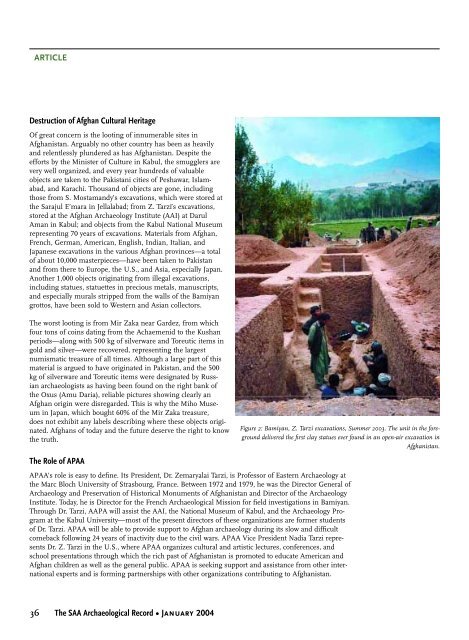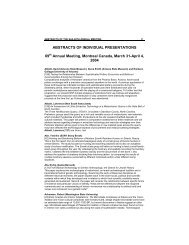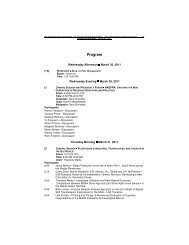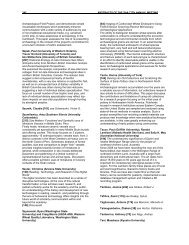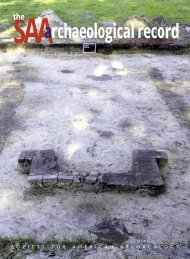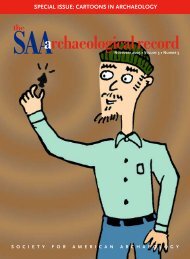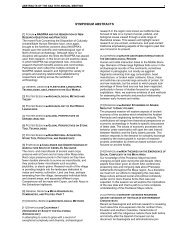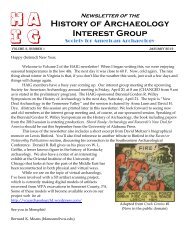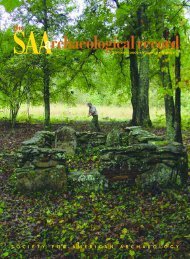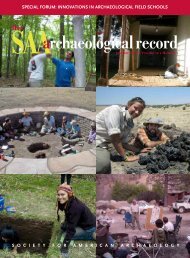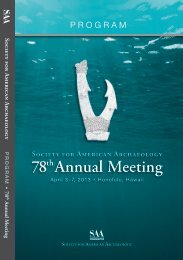Number 1, January - Society for American Archaeology
Number 1, January - Society for American Archaeology
Number 1, January - Society for American Archaeology
Create successful ePaper yourself
Turn your PDF publications into a flip-book with our unique Google optimized e-Paper software.
ARTICLE<br />
Destruction of Afghan Cultural Heritage<br />
Of great concern is the looting of innumerable sites in<br />
Afghanistan. Arguably no other country has been as heavily<br />
and relentlessly plundered as has Afghanistan. Despite the<br />
ef<strong>for</strong>ts by the Minister of Culture in Kabul, the smugglers are<br />
very well organized, and every year hundreds of valuable<br />
objects are taken to the Pakistani cities of Peshawar, Islamabad,<br />
and Karachi. Thousand of objects are gone, including<br />
those from S. Mostamandy’s excavations, which were stored at<br />
the Sarajul E’mara in Jellalabad; from Z. Tarzi’s excavations,<br />
stored at the Afghan <strong>Archaeology</strong> Institute (AAI) at Darul<br />
Aman in Kabul; and objects from the Kabul National Museum<br />
representing 70 years of excavations. Materials from Afghan,<br />
French, German, <strong>American</strong>, English, Indian, Italian, and<br />
Japanese excavations in the various Afghan provinces—a total<br />
of about 10,000 masterpieces—have been taken to Pakistan<br />
and from there to Europe, the U.S., and Asia, especially Japan.<br />
Another 1,000 objects originating from illegal excavations,<br />
including statues, statuettes in precious metals, manuscripts,<br />
and especially murals stripped from the walls of the Bamiyan<br />
grottos, have been sold to Western and Asian collectors.<br />
The worst looting is from Mir Zaka near Gardez, from which<br />
four tons of coins dating from the Achaemenid to the Kushan<br />
periods—along with 500 kg of silverware and Toreutic items in<br />
gold and silver—were recovered, representing the largest<br />
numismatic treasure of all times. Although a large part of this<br />
material is argued to have originated in Pakistan, and the 500<br />
kg of silverware and Toreutic items were designated by Russian<br />
archaeologists as having been found on the right bank of<br />
the Oxus (Amu Daria), reliable pictures showing clearly an<br />
Afghan origin were disregarded. This is why the Miho Museum<br />
in Japan, which bought 60% of the Mir Zaka treasure,<br />
does not exhibit any labels describing where these objects originated.<br />
Afghans of today and the future deserve the right to know<br />
the truth.<br />
The Role of APAA<br />
Figure 2: Bamiyan, Z. Tarzi excavations, Summer 2003. The unit in the <strong>for</strong>eground<br />
delivered the first clay statues ever found in an open-air excavation in<br />
Afghanistan.<br />
APAA’s role is easy to define. Its President, Dr. Zemaryalai Tarzi, is Professor of Eastern <strong>Archaeology</strong> at<br />
the Marc Bloch University of Strasbourg, France. Between 1972 and 1979, he was the Director General of<br />
<strong>Archaeology</strong> and Preservation of Historical Monuments of Afghanistan and Director of the <strong>Archaeology</strong><br />
Institute. Today, he is Director <strong>for</strong> the French Archaeological Mission <strong>for</strong> field investigations in Bamiyan.<br />
Through Dr. Tarzi, AAPA will assist the AAI, the National Museum of Kabul, and the <strong>Archaeology</strong> Program<br />
at the Kabul University—most of the present directors of these organizations are <strong>for</strong>mer students<br />
of Dr. Tarzi. APAA will be able to provide support to Afghan archaeology during its slow and difficult<br />
comeback following 24 years of inactivity due to the civil wars. APAA Vice President Nadia Tarzi represents<br />
Dr. Z. Tarzi in the U.S., where APAA organizes cultural and artistic lectures, conferences, and<br />
school presentations through which the rich past of Afghanistan is promoted to educate <strong>American</strong> and<br />
Afghan children as well as the general public. APAA is seeking support and assistance from other international<br />
experts and is <strong>for</strong>ming partnerships with other organizations contributing to Afghanistan.<br />
36 The SAA Archaeological Record • <strong>January</strong> 2004


